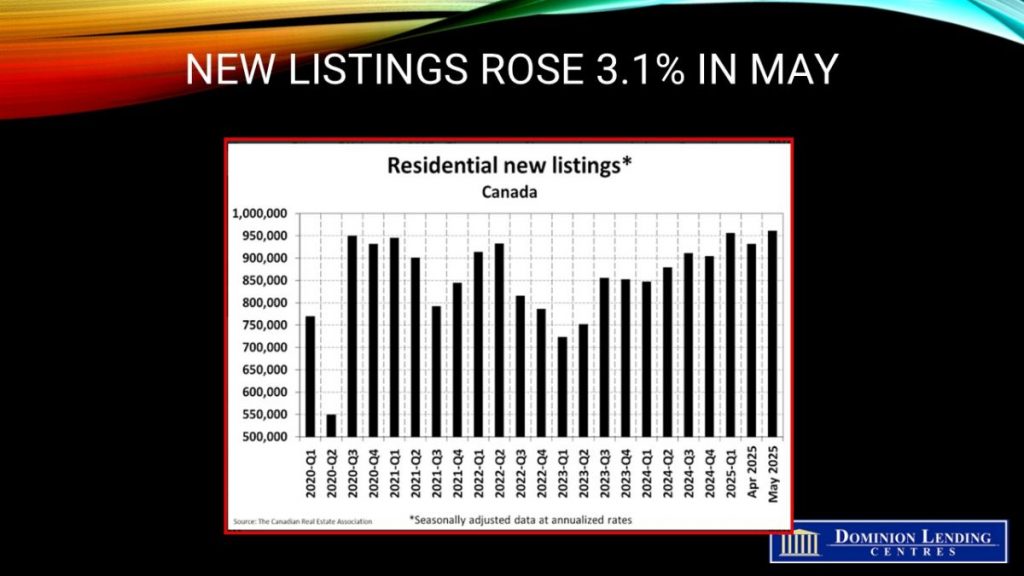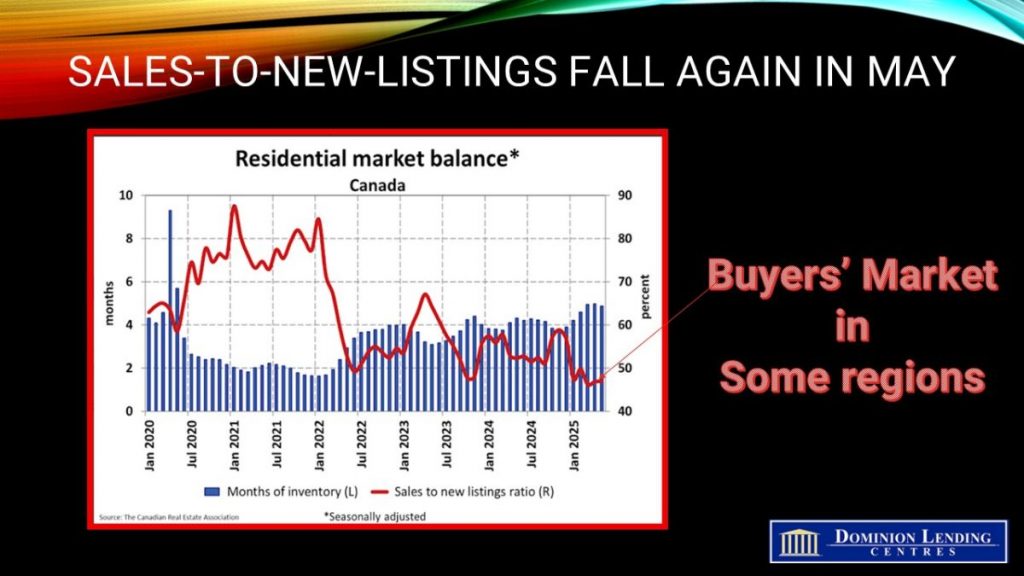Articles
Posted on June 16, 2025
Canadian national home sales were up 3.6% month-over-month
Global Tariff Uncertainty Sidelines Buyers
Canadian existing home sales recorded over the MLS Systems climbed 3.6% between April and May, a normally strong month for housing, marking the first gain in activity since last November.
The Greater Toronto Area (GTA), Calgary, and Ottawa led the monthly increase.
“May 2025 not only saw home sales move higher at the national level for the first time in more than six months, but prices at the national level also stopped falling,” said Shaun Cathcart, CREA’s Senior Economist. “It’s only one month of data, and one car doesn’t make a parade, but there is a sense that maybe the expected turnaround in housing activity this year was just delayed for a few months by the initial tariff chaos and uncertainty.”

New Listings
New supply declined by 1% month-over-month in April. Combined with flat sales, the national sales-to-new listings ratio climbed to 46.8% compared to 46.4% in March. The long-term average for the national sales-to-new listings ratio is 54.9%, with readings between 45% and 65% generally consistent with balanced housing market conditions.
At the end of April 2025, 183,000 properties were listed for sale on all Canadian MLS® Systems, up 14.3% from a year earlier but still below the long-term average of around 201,000 listings.
“The number of homes for sale across Canada has almost returned to normal, but that is the result of higher inventories in B.C. and Ontario, and tight inventories everywhere else,” said Valérie Paquin, CREA Chair.
There were 5.1 months of inventory on a national basis at the end of April 2025, which is in line with the long-term average of five months. Based on one standard deviation above and below that long-term average, a seller’s market would be below 3.6 months and a buyer’s market above 6.4 months.
New supply rose by 3.1% month-over-month in May. Given a similar increase in sales activity, the national sales-to-new listings ratio was 47%, almost unchanged from 46.8% in April. The long-term average for the national sales-to-new listings ratio is 54.9%, with readings between 45% and 65% generally consistent with balanced housing market conditions.
At the end of May 2025, 201,880 properties were listed for sale on all Canadian MLS® Systems, up 13.2% from a year earlier but remaining about 5% below the long-term average of around 211,500 listings for the month.
“May saw an increased number of new listings hitting the market early in the month, followed by a higher number of transactions in the second half of the month, so overall more sellers and buyers compared to April,” said Valérie Paquin, CREA Chair. “It seems like this may carry over into June as well.”
There were 4.9 months of inventory nationally at the end of May 2025, near the long-term average of five months. Based on one standard deviation above and below that long-term average, a seller’s market would be below 3.6 months, and a buyer’s market would be above 6.4 months.
Home Prices
The National Composite MLS® Home Price Index (HPI) was relatively unchanged (-0.2%) from April to May 2025. The pause follows three straight month-over-month declines of closer to 1%. The non-seasonally adjusted National Composite MLS® HPI was down 3.5% compared to May 2024.

Bottom Line
The First-Time Homebuyers GST Rebate on newly built homes took effect for purchase agreements dated on or after May 27. This may bring some additional buyers into sales offices, but it’ll be a while before those projects break ground and show up in the housing starts statistics.
In the resale market, May saw the first signs of optimism in home sales in six months, but sales remain at the low end of seasonal norms. While trade war uncertainty still looms, average and benchmark prices have fallen to about 17% below their early 2022 peaks. The opportunity may have been too good for some buyers to pass up.
New listings picked up about 3% from April, while inventory held steady at nearly five months. With this excess supply in the market, average sale prices ticked up only slightly in May but remain flat over the past year, while the benchmark price declined marginally.
Regional differences remained significant. Home sales reversed course in Quebec City, but the average selling price increased, reaching a new high. Despite stronger sales in Toronto and Vancouver, these cities remained deep in buyer’s market territory.
While one good month of home sales doesn’t make a trend, there may be signs of cautious optimism for the resale market for those buyers who remain little affected by the ongoing trade war. The combination of lower prices, more inventory and less economic uncertainty should continue to entice more homebuyers back into the market this summer. This would be more likely if the Bank of Canada cuts rates again, which could well happen in July if the inflation readings improve, especially for core inflation.



